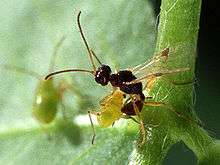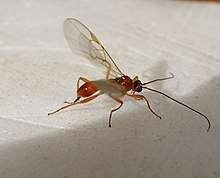Euphorinae
The Euphorinae are a large subfamily of Braconidae parasitoid wasps. Some species have been used for biological pest control. They are sister group to the Meteorinae.
| Euphorinae | |
|---|---|
 | |
| Peristenus digoneutis | |
| Scientific classification | |
| Kingdom: | Animalia |
| Phylum: | Arthropoda |
| Class: | Insecta |
| Order: | Hymenoptera |
| Family: | Braconidae |
| Subfamily: | Euphorinae Förster, 1862 |
| Tribes | |
|
Several, see text | |

| Wikispecies has information related to Euphorinae |
Description and distribution
Euphorines are small, usually dark colored wasps. They are non-cyclostomes. Euphorines are found worldwide.[1]
Biology
Euphorines are solitary or rarely gregarious koinobiont endoparasitoids. Unlike most other parasitoid wasps, Euphorinae have a broad host range and attack adult insects or nymphs of hemimetabolous insects.
Wasps of the tribe Dinocampini parasitize adult beetles.[2] Its four genera are Dinocampus Foerster, Ropalophorous Curtis, Centistina Enderlein, and Betelgeuse.[2]
Tribes
Representative tribes of Euphorinae are Centistini, Cosmophorini, Cryptoxilonini, Dinocampini, Euphorini, Helorimorphini, Meteorini, Myiocephalini, Oncometeorini, Perilitini, Proclithrophorini, Syntretini, and Tainitermini.
Genera
These 36 genera belong to the subfamily Euphorinae:
- Allurus Förster, 1862 c g
- Aridelus Marshall, 1887 c g b
- Bracteodes De Saeger, 1946 c g
- Centistes Haliday, 1835 c g
- Centistina Enderlein, 1912 c g
- Chrysopophthorus Goidanich, 1948 c g b
- Cosmophorus Ratzeburg, 1848 c g
- Cryptoxilos Viereck, 1911 c g b
- Dinocampus Förster, 1862 c g b
- Eadya Huddleston & Short, 1978 c g
- Ecclitura Kokujev, 1902 c g
- Elasmosoma Ruthe, 1858 c g b
- Euphoriella Ashmead, 1900 g b
- Euphorus Nees, 1834 g
- Kollasmosoma van Achterberg & Argaman, 1993 c g
- Leiophron Nees von Esenbeck, 1818 c g b
- Marshiella Shaw, 1985 c g
- Meteorus Haliday, 1835 c g b
- Microctonus Wesmael, 1835 c g b
- Myiocephalus Marshall, 1897 c g
- Neoneurus Haliday, 1838 c g b
- Perilitus Nees von Esenbeck, 1818 c g
- Peristenus Foerster, 1862 g b
- Proclithrophorus Tobias & Belokobylskij, 1981 c g
- Pygostolus Haliday c g b
- Rilipertus Haeselbarth, 1996 c g
- Ropalophorus Curtis, 1837 c g
- Spathicopis van Achterberg, 1977 c g
- Stenothremma Shaw, 1984 c g
- Streblocera Westwood, 1833 c g
- Syntretellus De Saeger, 1946 c g
- Syntretoriana Parrott, 1953 c g
- Syntretus Förster, 1862 c g b
- Townesilitus Haeselbarth & Loan, 1983 g b
- Wesmaelia Förster, 1862 c g
- Zele Curtis, 1832 c g
Data sources: i = ITIS,[3] c = Catalogue of Life,[4] g = GBIF,[5] b = Bugguide.net[6]
References
- Wharton, Robert A.; Marsh, Paul M.; Sharkey, Michael J. (1997). Manual of the New World Genera of the Family Braconidae (Hymenoptera) (PDF). Washington DC: The International Society of Hymenopterists. p. 69.
- Shaw, Scott Richard (1988). "A new Mexican genus and species of Dinocampini with serrate antennae (Hymenoptera; Braconidae; Euphorinae)" (PDF). Psyche. 95: 289–298. doi:10.1155/1988/98545. Retrieved 23 June 2011.
- "ITIS, Integrated Taxonomic Information System". Retrieved 2018-05-15.
- "Catalogue of Life". Retrieved 2018-05-15.
- "GBIF". Retrieved 2018-05-15.
- "Euphorinae Subfamily Information". BugGuide.net. Retrieved 2018-05-15.